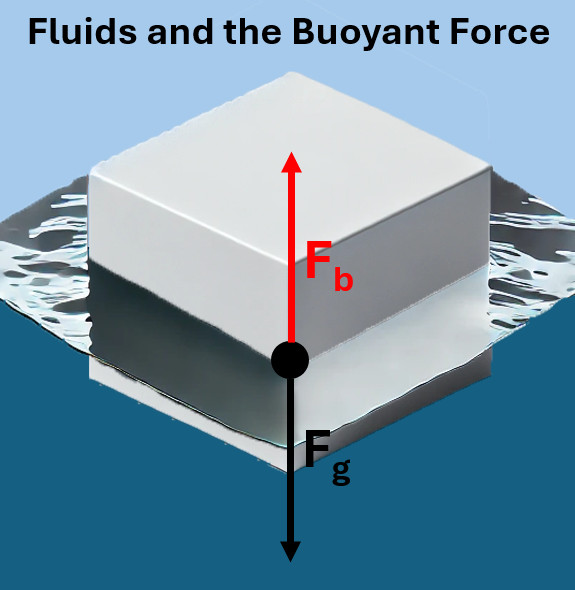Introduction
Building on concepts from Density of Fluids, Pressure in Fluids, and Relationship Between Density and Pressure, this lesson focuses on the buoyant force. This upward force is created when an object interacts with a fluid, displacing it and countering the downward pull of gravity.
What is the Buoyant Force?
The buoyant force arises due to differences in pressure at the top and bottom surfaces of a submerged object. As fluid is displaced, the upward force opposes gravity. The magnitude of the buoyant force is given by:
Fb=ρVg
Where:
- Fb: Buoyant force (N)
- ρ: Fluid density (kg/m3)
- V: Displaced fluid volume (m3)
- g: Gravitational field strength (N/kg : 9.8 N/kg on Earth)
Forces Acting When a Cube is Dropped into Water
When an object is dropped into water:
- Force of Gravity (Fg : also known as Weight): The force pulling the object downward, calculated as Fg=mg.
- Buoyant Force (Fb): The upward force increasing as more fluid is displaced.
- Net Force (Fnet): The combination of Fg and Fb determines whether the object sinks, floats, or suspends.
Example: Plastic Cube
- Material: Polyethylene plastic (ρ=950 kg/m3)
- Volume: V = 0.001 m3 (0.1 m length sides)
- Mass:
- m = ρV = 950×0.001 = 0.95 kg
- Weight:
- Fg = mg = 0.95×9.8 = 9.31 N
Interacting Forces Graphically as a 0.001 m3 Plastic Cube Submerges in Water:
The data shows how the forces interact as the plastic cube submerges:
Net Force (Fnet): Decreases, reaching equilibrium when Fb=Fg. Since the cube’s density is slightly less than water, it floats once fully submerged.
Weight (Fg): Constant at 9.31 N, representing the force of gravity.
Buoyant Force (Fb): Increases linearly as the cube displaces more water.

Buoyant Force and Net Force on the 9.31 N Plastic Cube Submerging in Water:
| Depth Submerged (m) | Fraction Submerged | Buoyant Force (Fb, N) | Net Force (Fnet, N) |
|---|---|---|---|
| 0.00 | 0.00 | 0.00 | 9.31 |
| 0.01 | 0.10 | 0.98 | 8.33 |
| 0.02 | 0.20 | 1.96 | 7.35 |
| 0.03 | 0.30 | 2.94 | 6.37 |
| 0.04 | 0.40 | 3.92 | 5.39 |
| 0.05 | 0.50 | 4.90 | 4.41 |
| 0.06 | 0.60 | 5.88 | 3.43 |
| 0.07 | 0.70 | 6.86 | 2.45 |
| 0.08 | 0.80 | 7.84 | 1.47 |
| 0.09 | 0.90 | 8.82 | 0.49 |
| 0.10 | 1.00 | 9.80 | -0.49 |
Factors Affecting the Buoyant Force

- No Dependence on Object Mass: The buoyant force depends only on the fluid density, displaced volume, and gravity.
- Proportional to Displaced Volume (V): As more of the cube submerges, the buoyant force increases linearly.
- Proportional to Fluid Density (ρ): A denser fluid, such as mercury, would exert a larger buoyant force for the same volume.
- Proportional to Gravitational Strength (g): On a planet with stronger gravity, the buoyant force would increase.
Buoyant Force vs. Fluid Density
This table and graph explore how buoyant force varies with fluid density for any cube with a side length of 0.1 m (volume V=0.001 m3), as long as it is fully submerged in the fluid on Earth (g=9.8 N/kg).

| Fluid Density (kg/m³) | Buoyant Force (Fb, N) |
|---|---|
| 500 | 4.90 |
| 850 | 8.33 |
| 1,000 | 9.80 (Water) |
| 1,200 | 11.76 |
| 13,600 | 132.88 (Mercury) |
Description:
The graph and table show how fluid density (ρ) directly affects the buoyant force (Fb). According to the equation Fb=ρVg, the buoyant force increases linearly as the fluid’s density rises, provided the cube remains fully submerged. For example, when you place the cube in water (ρ=1,000 kg/m3), the buoyant force reaches 9.8 N, which matches the cube’s weight (Fg=9.31 N). Consequently, the cube floats just below the water’s surface.
In contrast, when you submerge the cube in mercury (ρ=13,600 kg/m3), the buoyant force jumps dramatically to 132.88 N, far exceeding the cube’s weight. This strong upward force pushes the cube to float almost entirely above the mercury’s surface, illustrating how denser fluids generate significantly greater buoyant forces.
Example Problems
Problem 1: Solving for Fb
A plastic cube (V=0.001 m3) is fully submerged in water (ρ=1,000 kg/m3). Find Fb.
Solution:
Fb = ρVg = (1,000)(0.001)(9.8) = 9.8 N
Problem 2: Ranking Task
Rank buoyant forces in water (ρ=1,000 kg/m3), oil (ρ=850 kg/m3), and mercury (ρ=13,600 kg/m3) for the same cube.
Fluids and the Buoyant Force Conclusion
The buoyant force is independent of the object’s mass and depends solely on the fluid’s density, the displaced volume, and the gravitational strength. It increases proportionally to the displaced volume (V) as more of the object submerges, grows proportionally to the fluid density (ρ) in denser fluids like mercury, and strengthens with higher gravitational acceleration (g) on planets with stronger gravity.
To delve deeper into fluid concepts, join us in the next lesson, Floating in Fluids: Density and Volume and the Archimedes’ Principle, where we will explore buoyancy’s intricate connection to density and volume in even greater detail.
Links:
- Go back to the StickManPhysics AP Fluids Lessons Index
- See the StickManPhysics Table of Contents
- Go to our StickManPhysics Home Page

